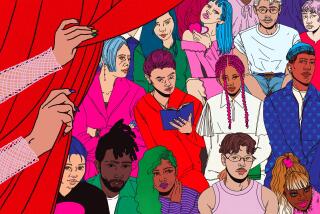How We Go From Victim to Victimizer and Back Again
Like any thinking person in America, feminist author Naomi Wolf is wrestling these days with the notion of victimization.
It’s in the context of that tumultuous debate that Wolf, in a movingly candid interview with journalist Lynn Darling, reveals an incident that still “haunts” her.
“While I was in college, I went to bed with a teen-age boy,” Wolf says. “I took his virginity, or he gave it to me. In any case, to me that was fun, it was a story my girlfriends and I could chuckle about. I treated him extraordinarily casually, and it turned out I really hurt him.”
Darling’s profile of Wolf, in the November Harper’s Bazaar, gives extraordinary insight into how one person’s--perhaps a whole movement’s--thinking matures as it sheds “us vs. them” posturing (possibly unavoidable in youth) and confronts head-on the complexity inherent in human relations.
Wolf mistreated that boy because she saw men as an oppressive class, in relation to which she, as a woman, could have no power.
As Reginald Denny discovered, though, oppression is sometimes most potent and painful on an individual level, at which point societal injustices become abstract.
In fact, the relationship between victim and victimizer, individual rights and group rights are always convoluted. Duke University professor Stanley Fish makes that clear in an intricate argument in support of affirmative action, excerpted from his new book in the November Atlantic Monthly--which also debuts the magazine’s subtle redesign.
Because blacks are historically--and still--the victims of racial oppression, he says, it is only fair that they be granted special access to the institutions that have systematically excluded them.
At times subtle and eloquent, at times hyperbolic and strident, Fish is unconvincing in his contention that affirmative action is, in its essence, fair. At the same time, however, he makes a solidly persuasive case that affirmative action is the right thing, regardless.
Fish, who says he recently was passed over for an academic post that will go to a woman or a minority candidate, says his hurt was assuaged by these facts: The choice was not made as a personal slight against him nor as an intentional affront to his race and gender, but in consideration of historical context and in pragmatic understanding that diversity would benefit the university.
Those who doubt the “V” word is a hot topic might pick up the November issue of The New Democrat (Six times a year, $18, 518 C St. NE, Wash. D.C. 20002), in which a cluster of bright writers tear into “the cult of victimization.”
This chorus is particularly noteworthy because The New Democrat is the organ of the Democratic Leadership Council, the influential think tank/activist organization of which President Bill Clinton, Vice President Al Gore and several cabinet members and advisers are charter members.
In one well-reasoned essay, Errol Smith, an African-American Angeleno and businessman says that while “leveraging white guilt to get concessions” was a viable strategy during the early years of civil rights struggle, it won’t work to improve the lives of blacks who remain “poor and socially dysfunctional.”
What will work is a wider distribution of the values--hard-work, cohesive families, etc.--that have already allowed 70% of African-Americans to pull themselves from poverty in the past 25 years, despite racism, Smith says.
In a similar vein, Los Angeles businessmen Steve Moya and Harry Pachon argue that Latinos, far from being a victim class, should be viewed as “an underutilized and underappreciated resource.”
Author Jonathan Rauch says that gays and lesbians are already backing away from a brief infatuation with “oppression politics,” having learned that “to keep the winnings of victimhood, you must continue to play the victim. . . . You may, in time, imprison yourself in the politics of inferiority and irreconcilable differentness--the very prison your oppressor once sought to build for you.”
John Huang points to the stunning success of Chinese-American banking institutions as an example to still-struggling minorities, and Forescee Hogan-Rowles describes how the Los Angeles-based Coalition for Women’s Economic Development helps poor women “achieve self-sufficiency through self-employment.”
Finally, Karen Lehrman (who recently critiqued women’s studies programs in Mother Jones) brings victimization back to the sort of personal issues discussed by Wolf.
“For feminism to work,” Lehrman writes, “it is crucial that women view themselves as strong, independent, autonomous equals, able to take responsibility for the actions and inaction. . . . Government cannot become the new Mr. Right.”
Required Reading: In the vernacular of The Source, all mad props to that magazine’s phat 50th issue. It’s hard to believe that commercial rap is almost 15 years old, and this issue is sure to school outsiders and newly arrived aficionados to the history of the hip-hop nation.
Of particular interest in this slickly produced package is a timeline listing watershed moments in the musical genre, and a group interview with three founding fathers: Afrika Bambaataa, Kool DJ Herc and Grandmaster Flash.
Magazine vs. Magazine: What’s happening at the Menendez brothers’ trial is a trashy disgusting, soap-operatic display of humanity at its sleaziest. And that’s just the behavior of those covering the action.
At least that’s Wil Runyon’s view, as reported in the November Los Angeles magazine. Aside from cable television host Skip E. Lowe, Vanity Fair’s Dominick Dunne takes the hardest hit.
“Dunne, who has made a lucrative career moralizing about the shallow lifestyles of the vulgar rich, seems to be the favored butt of ill will by other writers on the scene,” Runyon writes.
He quotes Spy’s John Connolly: “Everybody hates him.”
Shredder Fodder: Who’s more like Rush Limbaugh: Howard Stern or David Letterman? What are the key cultural and political implications of that comparison?
The correct answers, of course, are “Huh?” and “Who cares?”
But this week two magazines subject readers to lengthy analyses of the Limbaugh-Stern (Time) and Limbaugh-Letterman (New Republic) phenomena.
Most interesting revelation: Both Limbaugh and Stern were born on Jan. 12, and both claim to be “the most dangerous man in America.”
But there are more important things to fear than the three comedians in question.
For instance: You don’t need to buy the Clinton administration’s “politics of meaning” blather to be frightened by New Republic writer Alex Ross’ bizarre (and apparently un-ironic) implication that what the president and Gore must do to succeed in the “Letterman-Limbaugh culture,” is concoct ironic personas of their own.
The Time article is even more alarming for this revelation about the American public’s apparent lack of irony: According to a recent Time/CNN poll, 34% of all Americans and 48% of all Democrats think the government should not allow Limbaugh to make fun of the Clintons on the air.
New on Newsstands: Forbes MediaCritic joins a growing field of publications that perform the essential journalistic service of scrutinizing television, radio and print journalists who scrutinize everyone else on the planet.
The first issue of this new quarterly is lively and engaging as it examines the media through a largely conservative lens.
Stories include a look at “Health Care Myths,” by Fred Barnes and a skeptical analysis of multiculturalism in newsrooms, and an unflattering critique of the media’s allegedly fawning coverage of Hillary Clinton.
(1 year, four issues, 29.95; (800) 825-0061.
More to Read
Sign up for our Book Club newsletter
Get the latest news, events and more from the Los Angeles Times Book Club, and help us get L.A. reading and talking.
You may occasionally receive promotional content from the Los Angeles Times.







